Module2Unit1 教案-外研版七年级英语上册
外研版七年级英语上册教案Starter Module 2 Unit 1 Open your book

Unit 1 Open your book.
环节1 新课导入
T: Class,Please stand up. Hello, class.
S: Hello, Mr Wu.
T: Good morning,class.
S: Good morning,Mr Wu.
T: Please sit down.
S: Thank you.
At the same time,help the students understand the meaning with a gesture.
设计意图:以问答的方式进行教学,能很快导入课文,抓住学生的好奇心,吸引学生的学习兴趣。
环节2
1.播放录音,引导学生看活动1的图片感知整段对话。
2.再次播放录音,让学生跟读。
3.播放活动2的录音,让学生看图跟读并识记。
4.播放录音,要求学生做出对应的动作。
5.完成活动4的内容并核对答案。
6.完成活动5的笔头表达内容并核对答案。
7.两人一组,根据对方的指令做出对应的动作并给予回应。
板书设计
练习设计
请完成本课对应训练!。
外研版英语七年级上册StarterModule2Unit1《Openyourbook》说课稿
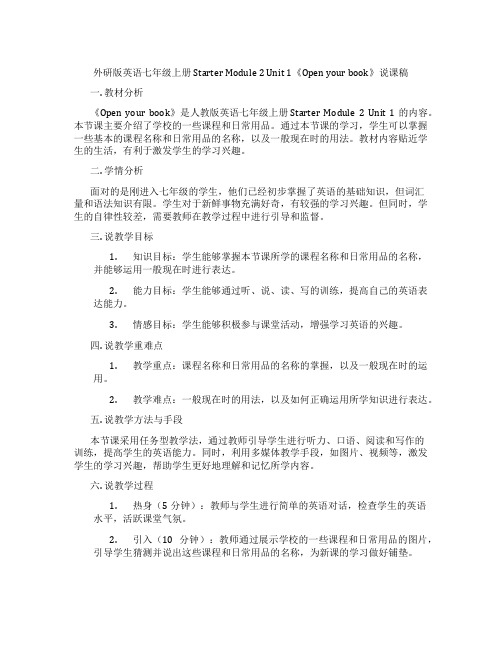
外研版英语七年级上册Starter Module 2 Unit 1《Open your book》说课稿一. 教材分析《Open your book》是人教版英语七年级上册Starter Module 2 Unit 1的内容。
本节课主要介绍了学校的一些课程和日常用品。
通过本节课的学习,学生可以掌握一些基本的课程名称和日常用品的名称,以及一般现在时的用法。
教材内容贴近学生的生活,有利于激发学生的学习兴趣。
二. 学情分析面对的是刚进入七年级的学生,他们已经初步掌握了英语的基础知识,但词汇量和语法知识有限。
学生对于新鲜事物充满好奇,有较强的学习兴趣。
但同时,学生的自律性较差,需要教师在教学过程中进行引导和监督。
三. 说教学目标1.知识目标:学生能够掌握本节课所学的课程名称和日常用品的名称,并能够运用一般现在时进行表达。
2.能力目标:学生能够通过听、说、读、写的训练,提高自己的英语表达能力。
3.情感目标:学生能够积极参与课堂活动,增强学习英语的兴趣。
四. 说教学重难点1.教学重点:课程名称和日常用品的名称的掌握,以及一般现在时的运用。
2.教学难点:一般现在时的用法,以及如何正确运用所学知识进行表达。
五. 说教学方法与手段本节课采用任务型教学法,通过教师引导学生进行听力、口语、阅读和写作的训练,提高学生的英语能力。
同时,利用多媒体教学手段,如图片、视频等,激发学生的学习兴趣,帮助学生更好地理解和记忆所学内容。
六. 说教学过程1.热身(5分钟):教师与学生进行简单的英语对话,检查学生的英语水平,活跃课堂气氛。
2.引入(10分钟):教师通过展示学校的一些课程和日常用品的图片,引导学生猜测并说出这些课程和日常用品的名称,为新课的学习做好铺垫。
3.讲解(15分钟):教师讲解一般现在时的用法,并通过例句让学生理解一般现在时的表达方式。
4.练习(10分钟):学生进行听力、口语、阅读和写作的训练,巩固所学知识。
5.课堂小结(5分钟):教师对本节课所学内容进行总结,强调一般现在时的用法。
外研版七年级英语上册教案完整版

2)练习询问姓名和相互间的问候。
What’s your name
I’m…
How are you I’m fine, thank you.
3)练习向别人介绍某人This is…
1)Work in pairs part7
教学目标
学习向别人介绍某人的用语
教学重点
This is my…She/He is…
教学难点
Be的变化运用
教具
多媒体、录音机
课时
1
教学课程
.
T: This is my friend…
S: Hello,…This is my father…
T: Nice to meet you.
S: Nice to meet you, too.
S: Hello, Ms…
T: Sit down please.
S: Thank you.
3.Drills
(1)练习打招呼问好。
(2)练习感谢他人。
(3)练习告别语Goodbye。
4.Practise
1)Work in pairs part7 and part8
2) Complete the sentences.
It’s a/an…book,bag,chair,desk…
教学难点
This/that的变化运用;a/an的运用
教具
多媒体、录音机
课时
1
教学课程
.
T: What’s this in English?
S: It’s a book.
T: How do you spell it?
外研版七年级英语上册Starter Module 2 (教学设计)

外研版英语七年级上册Starter Module 2Module 2 My English lessonUnit 1 Open your book .ⅠAnalysis of the text:This is the second module. Students should learn the classroom English in order to respond to the teacher’s words, and can corrrectly use them.ⅡArrangement of teaching in this moduleThree periods for this module, one period for one unit.ⅢTeaching focus:ⅰMaster language of useful expressions in the classroom .Key vocabulary and phrases:sit,down,open,book,listen,drow,put,up, stand, close.Useful sentences: Sit down.Stand up.Open your book.Close your book.Put up your hands.ⅱBe skilled in oral expression in the classroom.ⅣTeaching aims:ⅰ Function:useful expressions in the classroom.ⅱ Listening:Students can understand teacher’s words by listening.ⅲ Speaking:Students can use the sentences with others.ⅳ Reading:Students can understand the similar dialogues.ⅴ Writing: Students can write the useful words in their daily life.ⅤCharacter building:Motivate students’ interest in learning English.ⅥLearning strategies:Self study and Cooperate studyVII Teaching Procedures:Part I: Lead in:Step 1: Greeting with the students.Step 2: Use the classroom English in the class .Part II:Vocabulary study:Step 1:Play the recording and have them point out the words and phrases in Activity 2.Step 2: Play the recording again and have them read after the tape.Step 3: Have the students match the phrases and pictures in PPT.Step 4: Have the students match the phrases and pictures in Activity 4 and check their answer with their partner.PartⅢ: Dialogue study:Step1:Practise the dialogue with the whole class and have them make corresponding reacts.Step 2: Have students to practise the previous dialogue with their partner.Step 3: Work in pairs and do the Activity 2.Step 4: Work in pairs and practise the dialogue in Activity 2. Have some of them to perform their dialogue for the whole class.Unit 2 Good morning. I’m Chen Zhong.ⅠAnalysis of the text:In this text students will learn how to count number from one to ten.ⅡArrangement of teaching in this moduleThree periods for this module, one period for one unit.ⅢTeaching focus:ⅰMaster language of English numbers from 1 to 10.Key vocabulary and phrases: new, student, here, in, one, two, three, four, five, six, seven, eight, nine, ten, telephone, numberUseful sentences: -- Are you a new student here?-- Yes, I am.-- What class are you in?--I’m in Class 3.--What’S your number?--It’s…ⅱBe skilled in oral expression of English number from one to ten.ⅣTeaching aims:ⅰ Function:learn to how to ask others’ Class and telephone numbers .ⅱ Listening:Students can answer the questions by listening.ⅲ Speaking:Students can ask and answer in pairs.ⅳ Reading:Students can understand the similar dialogues.ⅴ Writing: Students can write their Class and telephone numbers.ⅤLearning strategies:Self study and Cooperate studyⅥTeaching Procedures:Part I: Lead in:Step1:Review the last lesson in the previous period by having the whole class play the dialoge in real situation .Step 2: Ask students to act with the classmates.Part II: Vocabulary study:Step 1:Play the recording and have them point out the words and phrases in Activity 1, 3 and 4.Step 2: Play the recording again and have them read after the tape.Step 3: Write the words in Activity 7.PartⅢ: Dialogue study:Step 1: Listen sentences in Activity 4Step 2: Teacher practise a dialogue with single student as follows: -- Are you a new student here?-- Yes, I am.-- What class are you in?--I’m in Class 3.--What’S your number?--It’s…Step 3: Work in pairs and practise the dialogue in Activity 6. Have some of them to perform their dialogues.Unit 3 This is my friend.ⅠAnalysis of the text:In this text students will learn how to introduce their ages and English numbers from eleven to twenty..ⅡArrangement of teaching in this moduleThree periods for this module, one period for one unit.ⅢTeaching focus:ⅰMaster language of say your age and learn the numbers from 11 to 20.Key vocabulary and phrases:old,twelve,eleven,thirteen,fourteen,fifteen, sixteen, seventeen, eighteen, nineteen, twenty, boy, girl, chair, bagUseful sentences: -- How old are you?--I’m twelve.-- How many boys are there?-- 15.ⅱBe skilled in oral expression of English number from eleven to twenty.ⅣTeaching aims:ⅰ Function:learn to use the numbers from 11-20.ⅱ Listening:Students can understand numbers from 11-20.ⅲ Speaking:Students can say numbers from 11-20.ⅳ Reading:Students can understand the similar dialogues.ⅴ Writing: Students can write the numbers from 11-20.ⅤLearning strategies:Self study and Cooperate studyVI Teaching Procedures:Part I: Lead in:Step1:Review the last two lessons in the previous period by having the whole class play the dialoges in real situation .Part II: Vocabulary study:Step 1:Play the recording and have them point out the words and phrases in Activity 1.Step 2: Play the recording again and have them read after the tape.Step3: Have the students match the words in Activity 3and check their answer with their partner.Step 4: Listen the dialogue in Activity 4 and point.Step 5: Write the right numbers in Activity 5.Step 6: listen to the tape and write the numbers in Activity 6.PartⅢ: Dialogue study:Step 1: Listen sentences in Activity 8 and practice.Step 2: Work in group of 4 and match in Activity 7, then have some groups of them to perform the dialoge for the whole class.。
外研版英语七年级上册 Module2 Unit1课件

pron. 那些
讲解: those指示代词,意为“那些”,是指 示代词that的复数形式。其对应词为 these,意为“这些”,是指示代词this 的复数形式。“Those/These are+复数 名词.”用来介绍两个或两个以上的 人或物,意为“那些/这些是……”。
例句: Those are her pencils.
复数:photos
短语:a photo of… 一张……的照 片take a photo/take photos 拍照take a photo of/take photos of 给……拍照
例句:
This is a photo of my family.
pron. 这些
例句: These are my sisters. 拓展: this pron. 这,这个(指较近的
例句: —Who’s he? —He is my father.
注意: 当用who提问,不知道是谁或不知 道人的数量时,问句中的谓语动词 用单数形式,而在回答时,则可以 根据实际情况回答。
n. 成年女子;妇女
复数:women 例句: Do you know the woman in black?
adj. 紧挨着,紧靠着 adv. 紧接下来地,下
一步
短语: next to 在……旁边,紧挨着 例句:
Don’t sit next to me.
在……旁边, 紧挨着
讲解: next to意为“在……旁边,紧挨 着”,其中to是介词,其后接名 词或代词作宾语。其后接人称代 词时,要用宾格形式。
例句: The school is next to the hospital.
n. 丈夫
例句: This is my husband, Steve.
外研版初中英语七年级上册(WY)教案 Module 1 Unit 2

Book1 Module1My classmates一、教学内容:Unit2 I ‘m Wang Lingling and I’m thirteen years old二、课型:Reading and writing三、教学目标:1、能够正确使用下列单词和词组:but, everyone, capital, last name,first name,big,small.2、能够读懂别人的自我介绍的短文。
3、能够对别人进行自我介绍和能介绍别人。
4、在跟不同地区的人交流时,学会尊重不同地域不同的表达习惯,理解他人。
四、教学重难点:1、掌握本课新词和词组2、掌握中外不同的姓名表达习惯:first name, last name3、能够进行简单的自我介绍五、教学准备:课堂整体运用任务型教学模式, 创设真实语境,通过个人呈现,同伴互动,小组活动等师生、生生的交流,充分体现了学生在学习过程中的主体地位,教师只是课堂的引导者,组织者和合作者.本课指导学生通过阅读获取信息,培养学生阅读技能。
在教学过程中,采用多媒体手段辅助教学,利用各种图片和习题任务贯穿整个教学过程。
因此,本节课需准备:PPT课件、课堂练习表格、奖品六、教学过程:words study.1、Lead the students to learn t he new w ords in groups.2、Show the sentences about the new words in this unit and some pictures.3、Choose the little teacher to teach the new words and the teacher correct the mistakes.4、Check the exercise in Activity 1.groups.2、Fill in the blanks.Check the answers with the whole class.3、Little teacher toteach the newwords.The other s toread after the little teacher.4、Competitive in the whole class..estions.②Let the students read Paragraph 1 in groups of six and find out difficulties.③Solve difficulties.T: Let’s continue learning Paragraph 2.(2) Paragraph 2:①Present someread Paragraph 2 and the students listen carefully to point out important Solve lasttalking.knowstudentsblanks③One team studentsread Paragraph 2 and the other students pointout difficultiespoints.④Tosay thedifficulties and solve together.(3)Read the Paragraph3.① Fill in the blanksafter reading paragraph3readingstudents to check the answersfirst andAsk a group of sixread paragraph 3. Let thestudentsandout My name is ______ _______I’mfrom__________.It’s a _____city in England. Tony is my ______name and Smith is my ________name.I’m thirteen______old.It’s nice to_____ you all.②The students check the answers in groups first and then competive.③ A group of six students to read paragraph 3. The other1.Retell.①Let the students fillin the blanks accordingto the pict ure .②Call back the answersfrom two students thenread the short passagein the whole class .2.Speaking①Ask and answer about the people in the pictures.②Ask some students to come to the blackboard and introduce七、板书设计:Module 1 Unit 2 I ‘m Wang Lingling and I’m thirteen yearsoldWhat’s your name? My name is…Where are you from? I’m from…Nice to meet you, … Nice to meet you, too.达标训练题(100分)一、阅读文章,从中找出重要信息填写下面的表格。
外研版七年级英语上册教学设计:《Module 2 Unit 1 Open your book》

外研版七年级英语上册教学设计:《Module 2 Unit 1 Open your book》一. 教材分析《Module 2 Unit 1 Open your book》这一课主要让学生掌握如何用英语介绍学校里的课程和图书。
通过学习本节课,学生能够理解并在适当的情境中运用核心句型“What subject do you like?”, “I like science.” 以及“Can I borrow this book?” 等进行日常交流。
教材内容丰富,包括图片、文本、练习等,有助于激发学生的学习兴趣和积极性。
二. 学情分析七年级的学生已经掌握了一定的英语基础知识,具备一定的听说读写能力。
他们在学习本节课时,能够通过图片和文本理解课程内容,但在运用英语进行表达时,可能会存在一定的困难。
因此,在教学过程中,需要关注学生的个体差异,因材施教,鼓励每个学生积极参与课堂活动。
三. 教学目标1.知识目标:学生能够掌握表示学科的词汇如 math, science, Chinese,English 等;能够运用核心句型 What subject do you like? 和 Can I borrow this book? 进行日常交流。
2.能力目标:学生能够在适当的情境中运用所学知识进行交际,提高听、说、读、写的能力。
3.情感目标:培养学生对英语学习的兴趣,增强自信心,乐于参与课堂活动。
四. 教学重难点1.重点:学生能够掌握表示学科的词汇和核心句型,进行简单的日常交流。
2.难点:学生能够在适当的情境中运用所学知识进行交际,提高听、说、读、写的能力。
五. 教学方法1.任务型教学法:通过设定各种真实的任务,让学生在完成任务的过程中运用所学知识,提高实际运用能力。
2.情境教学法:创造各种情境,让学生在真实的环境中感受和理解英语。
3.小组合作学习:鼓励学生之间进行合作交流,共同完成任务,提高团队协作能力。
六. 教学准备1.教材:《Module 2 Unit 1 Open your book》相关教学材料。
2019-2020年七年级英语上册 预备篇Module 2 Unit 1 It’s a classr
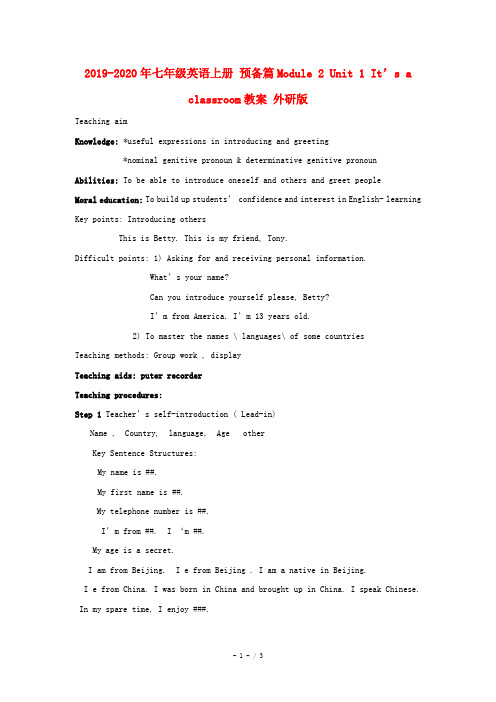
2019-2020年七年级英语上册预备篇Module 2 Unit 1 It’s aclassroom教案外研版Teaching aimKnowledge: *useful expressions in introducing and greeting*nominal genitive pronoun & determinative genitive pronounAbilities: To be able to introduce oneself and others and greet peopleMoral education:To build up students’ confidence and interest in English- learning Key points: Introducing othersThis is Betty. This is my friend, Tony.Difficult points: 1) Asking for and receiving personal information.What’s your name?Can you introduce yourself please, Betty?I’m from America. I’m 13 years old.2) To master the names \ languages\ of some countriesTeaching methods: Group work , displayTeaching aids: puter recorderTeaching procedures:Step 1 Teacher’s s elf-introduction ( Lead-in)Name , Country, language, Age otherKey Sentence Structures:My name is ##.My first name is ##.My telephone number is ##.I’m from ##. I ‘m ##.My age is a secret.I am from Beijing. I e from Beijing . I am a native in Beijing.I e from China. I was born in China and brought up in China. I speak Chinese. In my spare time, I enjoy ###.My E-mail Address is ##.Step 2 Foreign teacher’s introduction ( The same )This is our foreign teacher. (Name , Country, language, Age other)●Students’Activity: Listen and get some informationStep 3The students’ Introduction●Listen and prepare the introduction.●Introduce themselves according to the form.●Pair work; Introduce themselves.Step 4.Part One on the book.Lingling and Daming have a foreign friend. Her name is Betty. She is American. She is now a student. Please listen to the tape so that we can know more about Betty and other foreign friends. Please don’t open your books. Look at the blackboard. Listen and Answer.:1)Where is Betty from?2)Where is Tony from?3)How old are Betty, Tony, Daming and Linling?Work in pairs to practise the dialogue.●Students’activity: Listen to the tape; Practise their listening; Improve theirabilities of get informationStep 5 Learning the dialogue.Practise the listening skill & Role play●Students’ activity: Accordi ng to the form, they work in groups to practise thedialogue.Step 6 Show a map of the world to practise the names \ languages of the countries ●Listen and think so many foreign countries’names.Step7 Read aloud●The students read aloud to practise oral English.Step 8Choose to be one of the following WAB students. Look at the form on page 19. Step 9 Learning the language item.1)be happy/ excited/ delighted to…2)The names of the countries.●The students learn the language points.Homework: Introduce one of your pen-friends.-----如有帮助请下载使用,万分感谢。
七年级英语上册-Module-2-Unit-1-I-can-speak-English课件1-外研版
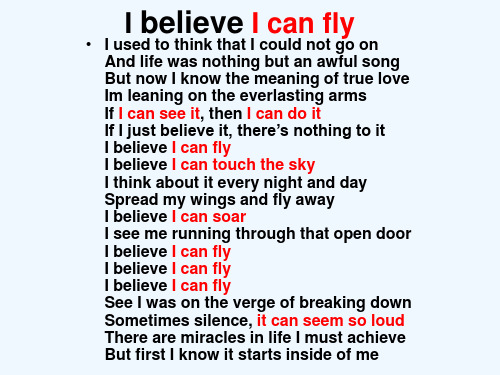
选择can或can’t填空
• Sorry,I c_a_n_’_t come to your birthday party.My mother is ill.
补充完整句子。
• Can they play football? • No,__th_e_y_ _c_an_’_t_.
英汉互译
• 1.弹钢琴 p_l_a_y_t_h_e_p_ia_n_o • 2.骑马_r_id_e_a__h_o_rs_e_ • 3.play tennis_打__网_球____ • 4.play basketball_打__篮__球__
4.play basketball_打__篮__球____
*Please welcome Betty and Tony to
our school. (1)welcome动词,意思是“欢迎”。例 如:They welcome me.
他们欢迎我。
(2)welcome to 意思是“欢迎到某 地”。例如:Welcome to China. 欢迎到 中国来。 (3)welcome sb. to…意为“欢迎某人 到某地”。
I believe I can fly
• I used to think that I could not go on And life was nothing but an awful song But now I know the meaning of true love Im leaning on the everlasting arms If I can see it, then I can do it If I just believe it, there’s nothing to it I believe I can fly I believe I can touch the sky I think about it every night and day Spread my wings and fly away I believe I can soar I see me running through that open door I believe I can fly I believe I can fly I believe I can fly See I was on the verge of breaking down Sometimes silence, it can seem so loud There are miracles in life I must achieve But first I know it starts inside of me
秋外研版七年级上册module2《my english lesson》优秀教案(重点资料).doc

Starter Module 2 My English lessonUnit 1 Open your book.学习内容:Starter Module 2 My English lessonUnit 1 Open your book.学习目标:1、To review the words and useful expressions in Unit 1 of Starter Module 2.2、To learn to use everyday English in this unit.3、To keep them in your mind.学习重点:1、词汇:sit, down, open, book, listen, draw, put, up, hand, stand, close.2、句型: --- Sit down. / Stand up.--- Open your book. / Close your bok.--- Put up your hand.学习时间:2课时学习方法:自主、合作与探究法学习过程:Step 1 Warming - up / Lead - in* 教师走进教室,学生起立向老师问好,教师问候学生,然后可以说:“Please sitdown.”并配以手势来请同学们坐下。
教师在真实的语境中引入了“Please sitdown.”这个重点句型,在手势的帮助下,学生应该能够理解这个句子的意思。
Step 2 Listening and reading1、Activity 1 Listen and read.2、Activity 2 Listen and repeat.3、Activity 3 Listen again and do.(1)播放录音,让学生做出相应的动作。
(2)在学生比较熟悉之后,变换形式进行游戏。
Step 3 Practice1、Activity 4 Match.* 学生个体活动,完成匹配。
秋季学期外研版初中七年级英语上册教案全册
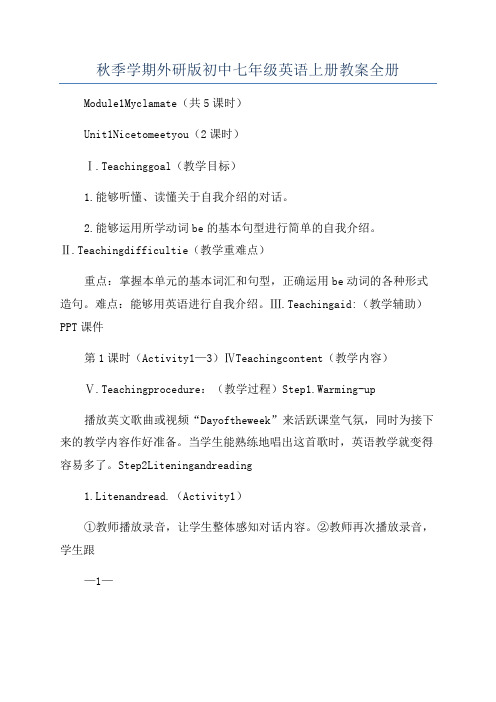
秋季学期外研版初中七年级英语上册教案全册Module1Myclamate(共5课时)Unit1Nicetomeetyou(2课时)Ⅰ.Teachinggoal(教学目标)1.能够听懂、读懂关于自我介绍的对话。
2.能够运用所学动词be的基本句型进行简单的自我介绍。
Ⅱ.Teachingdifficultie(教学重难点)重点:掌握本单元的基本词汇和句型,正确运用be动词的各种形式造句。
难点:能够用英语进行自我介绍。
Ⅲ.Teachingaid:(教学辅助)PPT课件第1课时(Activity1—3)ⅣTeachingcontent(教学内容)Ⅴ.Teachingprocedure:(教学过程)Step1.Warming-up播放英文歌曲或视频“Dayoftheweek”来活跃课堂气氛,同时为接下来的教学内容作好准备。
当学生能熟练地唱出这首歌时,英语教学就变得容易多了。
Step2Liteningandreading1.Litenandread.(Activity1)①教师播放录音,让学生整体感知对话内容。
②教师再次播放录音,学生跟—1—读、模仿。
③学生两人一组练习对话。
④教师让不同的小组展示对话,关注学生的发音。
2.Litenandrepeat.Nowpoint,akandanwer.(Activity2)①教师放录音,学生听录音。
②教师再次播放录音,学生跟读、模仿。
③学生两人一组根据日历练习对话。
④教师让部分小组展示对话。
环节说明:本活动以日历的形式让学生学习表示星期一至星期日的7个词汇,然后指着日历上的具体日期来询问星期几,进而练习相关句型“Whatdayiittoday”教师向学生说明在西方国家Sundayithefirtdayoftheweek,让学生了解这种文化差异。
Step3Practice1.Readandmatch.Nowlitenandcheck.(Activity3)①学生个体活动,完成匹配。
外研版七年级英语上册教案
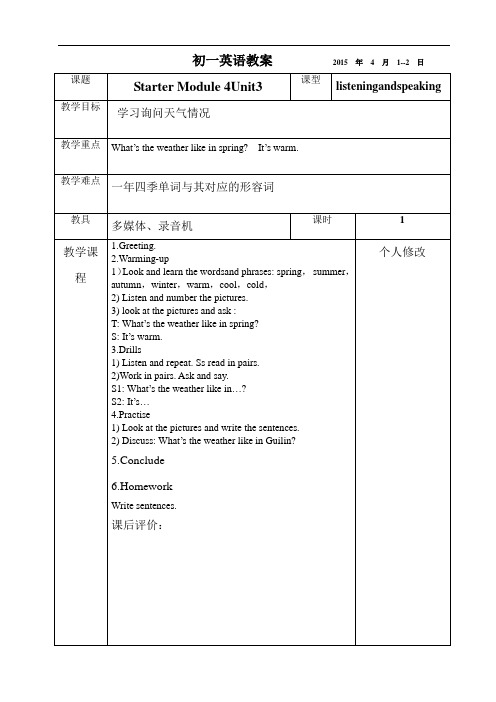
初一英语教案2015 年 4 月1--2 日教案年 4 月 3 日教案年 4 月7--8 日教案年 4 月17--20 日初一英语教案年4 月21--22 日初一英语教案年4月23--24 日初一英语教案年4月27--28 日初一英语教案年 4 月29--30 日初一英语教案年 5 月15--18 日初一英语教案年 5 月25--26 日初一英语教案年5月27--28 日初一英语教案年 5 月29 日初一英语教案年 6 月1--2 日课题Module 10 Unit 3课型Revision Language in use教学目标To summarise and consolidate grammar focus.To summarise and consolidate expressions and vocabulary.教学重点Present simple: interrogative, negative and affirmative sentences教学难点Present simple: interrogative, negative and affirmative sentences 教具多媒体、录音机课时 1教学过程Step 1. Revision新课标第一网个人修改(1). Revise the words about computers(2). Put the Ss. in pairs to introduce how to use a computer.Step nguage practice1. Run through the examples with the Ss. and make sure that theyare familiar with the use of adverbs of interrogative, negativeand affirmative sentences.2. Ask the Ss. To repeat the sentences in the box.3. Ask ”Can you make other similar examples?”4. Act.1 and Act.2 on page 64. Grasp the use of usually and often.Step 3. Test:课后评价。
外研版七年级英语上册StarterModule2MyEnglishlesson教案

外研版七年级英语上册StarterModule2MyEnglishlesson教案Module 2 My English lessonUnit 1 Open your book.Ⅰ. Analysis of the textIn this text students will learn how to recognize objects in the class.Ⅱ. Arrangement of teaching in this moduleThree periods for this module, one per iod for one unit.Ⅲ. Teaching focus1. Master language of asking the name of specific objects in the class, and master the words of objects in the class.K ey vocabulary and phrases: sit, down, sit down, open, book, listen, draw, put, up, hand, stand, stand up, close What’s this in English?, What’s this?, It’s…, instruction pronoun this.2. Be skilled in oral expression of asking the name of specific objects in the class and give corresponding answers.Ⅳ. Teaching aims1. Function: recognition of objects in the class.2. Listening: St udents can understand others’ questions of asking the names of specific objects, and give corresponding answers.3. Speaking: Students can ask and answer objects’ names.4. Reading: Students can understand the similar dialogue of asking and answering obje cts’ names.5. Writing: Students can write the names of objects in the class.Ⅴ. Teaching ProceduresPart I: Lead inStep 1: Review the greeting phrases in the previous period by having the whole class play the dialogue in real situation.Step 2: Ask some students to introduce their partners to the class.Step 3: Enjoy a song: Hello and how are you?Part II: Vocabulary studyStep 1: Show some pictures of objects in the class by PPT, give students the names of the objects.Step 2: Play the recording and have them point out the words and phrases in Activity 1.Step 3: Listen and read.Good morning, class.Good morning, Miss Zhou.Please s it down.Step 4: Play the recor ding and have them point out the words and phrases in Activity 2.Sit down.Open your bookListen.Draw.Put up your hand.Stand up.Close your book.Step 5: Play the recording again and have them read after the tape.Step 6: Listen again and do.Part Ⅲ: Dialogue studyStep 1: Teacher ask the whole class the objects in the PPT’s names.Step 2: Match the expressions in Activity 3.1. Put up a) your book2. Open b) …down3. Stand c)… up4. Sit d)…your hand.Step 3: Check the answers.Keys: 1. d 2. a 3. c 4. bStep 4: Write the letters in Activity 5.Step 5: Listen and check.Step 6: Work in pairs, one student point one object in the PPT, the other answer the question.Step 7: Work in pairs and fill the blanks in Activity 6. Have some of them to perform the dialogue for the whole class.Stand up.Yes.Open your book.Yes.Step 8: Work in pairs. Say and do.Unit 2 What’s your number?Ⅰ. Analysis of the textIn this text students will learn how to express English number.Ⅱ. Arrang ement of teaching in this moduleThree periods for this module, one period for one unit.Ⅲ.Teaching focusKey vocabulary and phrases: student, new, here, in, one, two, three, four, five, six, seven, eight, nine, ten, telephone, number Ⅳ. Teaching aims1. Function: recognition of numbers.2. Listening: Students can understa nd others’ questions of asking numbers, and give corresponding answers.3. Speaking: Students can ask and answer numbers.4. Reading: Students can understand the similar dialogue of asking and answering numbers.5. Writing: Students can write numbers.Ⅴ. Teaching ProceduresPart I: Vocabulary studyStep 1: Learn English number from one to ten.Step 2: Enjoy a song: Ten little Indians.Part II: Listening practice.Step 1: Look at the pictures in Activity 1.Step 2: Listen and read.—Hello. Are you a new student here?—Yes, I am.— What class are you in?—I’m in Class 3. Mr. Chen’s class.Ste p 3: Listen and repeat.one two three four fivesix seven eight nine tenStep 4: Listen and chant.One, two, three, four, five.Once I caught a fish alive.Six, seven, eight, nine, ten,Part III: Dialogue studyStep 1: Ask the students to read the conversation silently.Step 2: Play the recording and ask the students to listen and read the conversation. Step 3: Read the conversation.Step 4: Act it out.Step 5: Language pointsWhat’s your telephone number?What’s your telephone number? 用于询问对方的电话号码,回答时用“It’s +电话号码.”结构。
Starter Module 2Unit 1教案-外研版七年级英语上册
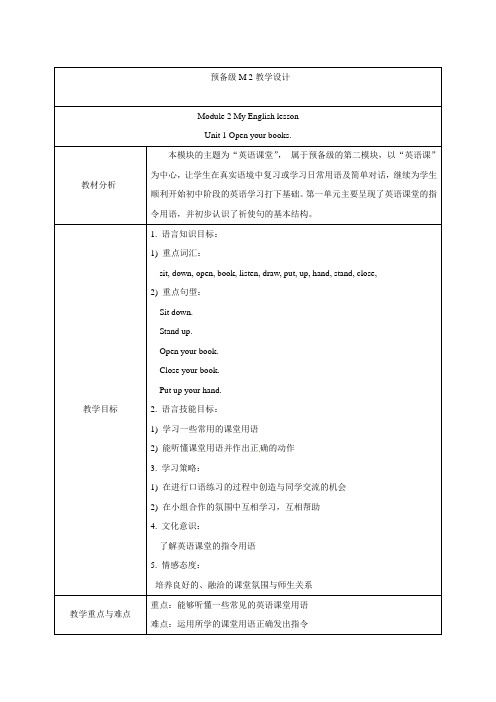
预备级M 2教学设计Module 2 My English lesson Unit 1 Open your books.教材分析本模块的主题为“英语课堂”,属于预备级的第二模块,以“英语课”为中心,让学生在真实语境中复习或学习日常用语及简单对话,继续为学生顺利开始初中阶段的英语学习打下基础。
第一单元主要呈现了英语课堂的指令用语,并初步认识了祈使句的基本结构。
教学目标1. 语言知识目标:1) 重点词汇:sit, down, open, book, listen, draw, put, up, hand, stand, close, 2) 重点句型:Sit down.Stand up.Open your book.Close your book.Put up your hand.2. 语言技能目标:1) 学习一些常用的课堂用语2) 能听懂课堂用语并作出正确的动作3. 学习策略:1) 在进行口语练习的过程中创造与同学交流的机会2) 在小组合作的氛围中互相学习,互相帮助4. 文化意识:了解英语课堂的指令用语5. 情感态度:培养良好的、融洽的课堂氛围与师生关系教学重点与难点重点:能够听懂一些常见的英语课堂用语难点:运用所学的课堂用语正确发出指令教学辅助电脑,投影仪,白板教学策略基于学生的学习水平和认知特点,采用启发式教学、互动式教学的策略教学内容教学活动设计意图教师活动学生活动步骤 1热身及新课导入(5 分钟)1. 热身活动1放音乐,全班跟着老师做热身操。
2. 新课导入1老师说:Today is a fine day. It’s time to havean English lesson now. Let’s come to Module 1,my …引出本模块的标题,让学生就着标题填空。
My ________ ________3. 新课导入2老师说:This is an English book. If you do likethis, you will find your friend, Lingling andTony. Let’s …引出本单元的标题,让学生就着标题填空。
七年级英语上册M2MyfamilyUnit1Isthisyourmum教案外研版(1)

Book1 Module 2 My Family一、教学内容:Unit 1 Is this your mum?二、课型:Listening and speaking三、教学目标:1. To talk about your family member s2. To listen and understand familiar topic3. To learn some key words and useful expressions四、教学重难点:1、单词和词组:brother, cousin, daughter, family, grandfather, parent, son, sister, unclea photo of… in front of… on the left next to2、能听读有关介绍家庭的简短对话,辨认对话中的人物关系。
3、能用指示代词来介绍自己的家庭,询问他人的家庭情况。
五、教学准备:本课指导学生通过听力获取信息,培养学生听力技能。
课堂上采用多媒体手段辅助教学,在轻松愉快的氛围中,在较真实的语境下,并联系学生生活实际,结合已有的知识和经验,运用所学的语言基础知识自我学习、互相学习,让学生在语言实践中相互启发、生成,体验成功。
培养学生的合作精神,发展其思维和想象等能力。
在教学过程中,采用多媒体手段辅助教学,利用各种图片和习题任务贯穿整个教学过程。
因此,本节课需准备:PPT课件、挂图、录音机、课堂练习表格、奖品。
六、预习要求:根据音标自学本课新单词;七、教学过程:教学步骤教师活动学生活动设计意图Step One Warming-up (3’)Lead in1. First :let the students seea video. It is a song aboutfamily。
And then answer:1.How many people are there inthe video ?2.Who are they ?Second: Greeting . Free talk tolead in our t oday’s module(Module2 My family Unit 1Is this your mum ? )1. Enjoy the video and tryto answer the questions .2. Talk with th e teacherand partners.学生们喜欢看动画,以一首歌曲导入新课,让学生进入英语的氛围当中,且激发了学生的学习兴趣,从而顺利的进入到新课的学习当中Step Two Pre-task Task1:Check the new words.1. Let the students see thescreen.A boy Tony and then study the new1.See the pictures andthings to say out the newwords.2. Read the new words利用多媒体生动形象的给学生们展示了新单词,(5’)words(about his family).anize the students to readthe n ew words together.3.Check the students’newwords learning according to theActivity 1 together.3. Check the students’new words learningaccording to the Activity1让学生们在轻松的环境下学会单词,通过图片、情景学单词,做到词不离句。
外研版英语七年级上册Module2 unit1课件

写出下列单词的对应词。
1.father__m_o_t_h_e_r 2. sister_b_r_o_t_h_e_r_ 3. uncle_a_u__n_t _ 4. grandfather__g_ra_n_d_m__o_t_h_e_r
___a_u_n_t_____ .
5. My mother’s brother is my
___u__n_c_l_e____. 6. My mother’s sister is my a_u__n_t_.
目标二:熟读并理解对话
This is a photo of Tony’s family.
学习目标
Module 2
Unit 1
Is this your mum?
总体设计思路
• 1.本节课的课型是一节听说课,训练学生 的听,说能力。
• 2.根据课标要求,本节课的语法项目有两 个,第一是掌握指示代词this,that, these,those的用法,第二是掌握方位介 词的用法。模块任务是学会用指示代词和 方位介词介绍自己的家庭。
I`m... next to ... in front of ... behind... on one`s left... on one`s right...
学习目标
• 1.学习单词词组 • 2.熟读并理解对话,掌握知识点 • ⑴指示代词this,these的用法。 • ⑵表示方位的介词及介词短语 • 3.介绍自己的家庭成员
my__p_a_r_en__ts___.
2. My grandfather and grandmother are my _g_r_a_n_d_p_a_r_e_n_t_s__ .
Module2Unit1教学设计2023-2024学年外研版七年级英语上册

题目:选择正确的一般现在时态。
句子:She (1) to the library every Saturday.
选项:A. goes B. going C. went D. gone
答案:A
解析:此题考查学生对一般现在时态的运用。根据句子中的时间状语“every Saturday”,应选用一般现在时,故选A。
5.例题5:句子排序题
题目:将句子按正确顺序排列。
句子:
1. She goes to school by bus.
2. Her mother is a doctor.
3. My mother cooks delicious food.
4. I usually have breakfast at 7:00 a.m.
4.教学手段:小组讨论、角色扮演、听力练习、口语练习、互动游戏。
教学过程设计
1.导入新课(5分钟)
目标:引起学生对日常活动的兴趣,激发其探索欲望。
过程:
开场提问:“你们知道日常活动用英语怎么说吗?它们是如何融入我们生活的?”
展示一些关于日常活动的图片或视频片段,让学生初步感受英语描述日常活动的魅力。
典型例题讲解
1.例题1:填空题
题目:用一般现在时填空。
例句:I (1) my schoolbag and (2) to school.
选项:A. put on B. take off C. go D. wear
答案:C A
解析:此题考查学生对一般现在时的掌握。根据句意,应选用“go”表示去学校,“put on”表示穿上书包。
2.提供丰富的语境和情景,让学生在实际情境中练习描述日常活动。
3.分组讨论和角色扮演,提高学生的口语交际能力和听力理解能力。
外研版英语七年级上册Module2Unit1《Isthisyourmum》说课稿
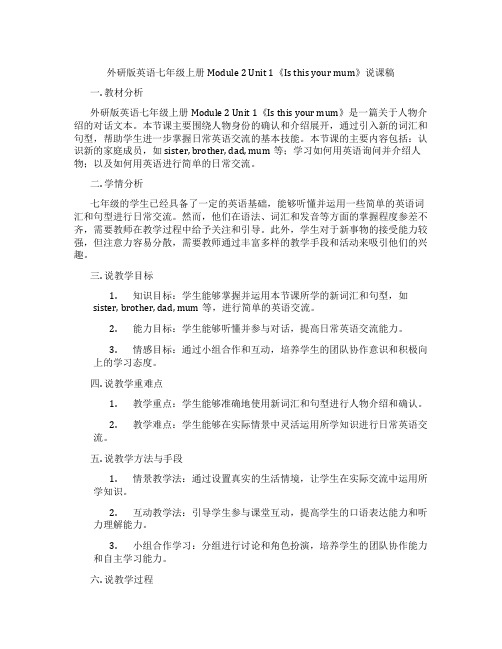
外研版英语七年级上册Module 2 Unit 1《Is this your mum》说课稿一. 教材分析外研版英语七年级上册Module 2 Unit 1《Is this your mum》是一篇关于人物介绍的对话文本。
本节课主要围绕人物身份的确认和介绍展开,通过引入新的词汇和句型,帮助学生进一步掌握日常英语交流的基本技能。
本节课的主要内容包括:认识新的家庭成员,如sister, brother, dad, mum等;学习如何用英语询问并介绍人物;以及如何用英语进行简单的日常交流。
二. 学情分析七年级的学生已经具备了一定的英语基础,能够听懂并运用一些简单的英语词汇和句型进行日常交流。
然而,他们在语法、词汇和发音等方面的掌握程度参差不齐,需要教师在教学过程中给予关注和引导。
此外,学生对于新事物的接受能力较强,但注意力容易分散,需要教师通过丰富多样的教学手段和活动来吸引他们的兴趣。
三. 说教学目标1.知识目标:学生能够掌握并运用本节课所学的新词汇和句型,如sister, brother, dad, mum等,进行简单的英语交流。
2.能力目标:学生能够听懂并参与对话,提高日常英语交流能力。
3.情感目标:通过小组合作和互动,培养学生的团队协作意识和积极向上的学习态度。
四. 说教学重难点1.教学重点:学生能够准确地使用新词汇和句型进行人物介绍和确认。
2.教学难点:学生能够在实际情景中灵活运用所学知识进行日常英语交流。
五. 说教学方法与手段1.情景教学法:通过设置真实的生活情境,让学生在实际交流中运用所学知识。
2.互动教学法:引导学生参与课堂互动,提高学生的口语表达能力和听力理解能力。
3.小组合作学习:分组进行讨论和角色扮演,培养学生的团队协作能力和自主学习能力。
六. 说教学过程1.导入:通过图片展示和教师示范,引导学生进入本节课的主题。
2.呈现:教师引导学生学习新词汇和句型,并通过示例进行讲解和示范。
3.操练:学生进行小组讨论和角色扮演,实践所学知识。
- 1、下载文档前请自行甄别文档内容的完整性,平台不提供额外的编辑、内容补充、找答案等附加服务。
- 2、"仅部分预览"的文档,不可在线预览部分如存在完整性等问题,可反馈申请退款(可完整预览的文档不适用该条件!)。
- 3、如文档侵犯您的权益,请联系客服反馈,我们会尽快为您处理(人工客服工作时间:9:00-18:30)。
教学设计
外语教学与研究出版社《新标准》英语初中一年级上册
Module Two My family
Unit 0ne Is this your mum?
一、教材分析
本课讲的是介绍自己的家庭成员。
本课中的功能句型“Is this/that …?/Are these/those …?/Who is this/that?/Who are these/those?”在前面已经学过This is….”,只要衔接自然,学生应该很容易掌握这个句型。
比较难的是学习这些家庭成员的词汇,使学生更容易接受新知。
二、学情分析
本课的教学对象是初一的学生。
在本节课中学习的句子是学生很感兴趣的话题,也很贴近生活。
学生应该很快就能掌握新学的句子。
但在句子中出现的grandparents, uncle,aunt,cousin,husband等词,让学生感到中西方文化的差异,要提醒学生多注意。
三、教学目标
1. 知识目标
(1)能听懂、会读、会说单词:mother, father, grandpa, grandma, sister, brother, aunt, daughter, family, grandfather, grandmother, grandparents, parents, son, uncle, these, they, who, woman, husband, those.
(2)能听懂、会读、会说句子:Is this/that your mother\father\grandpa\...? Are these/those …?/Who is this/that?/Who are these/those?
(3)语音能识别并正确朗读/h/,/b/,/p/
2.能力目标
(1)能听懂、会运用句型“This is ..../These are ..../Are these . (I)
this …?”介绍自己的家庭成员,以及询问他人的家庭成员;
(2) 能够跟录音有表情的朗读对话。
3.情感态度
培养学生学习英语的兴趣,大胆开口说英语,通过介绍和询问家庭成员,培养对家庭的热爱和家庭成员的关心,对家庭不幸的同学的同情和理解。
4.学习策略
1)自主学习,培养话题和词汇的语境意识,形成话题联想的习惯
2)小组合作,关心他人的家庭,培养移情策略
5.文化意识
了解中西方家庭的差异
四、教学重点和难点
重点:能听懂、使用单词:mother, father, grandpa, grandma, sister, brother, aunt, daughter, family, grandfather, grandmother, grandparents, parents, son, uncle, these, they, who, woman, husband, those.
难点:能在图片的提示下,在语句中正确认读单词:grandpa, grandma, sister, brother,aunt, daughter, family, grandparents, parents, son, uncle, these, woman, husband, those.
五、教学过程
Step1:warmi ng-up
1.Greetings
2.Sing a song “What’s thi s?
设计意图:用问候及唱英文歌曲,调动学生学习的热情。
Step2look and say
1.教师利用课件图片复习句型:This is my school\classroom\teacher.
设计意图:复习导入新课,引入话题
2.课件出示教师的一张同意,Tony’s全家福。
T: What’s this?
T:This is Ton y’s family.(教读新单词family)
T:How many people in my family? Let’s count.
Look, Is this his mother\father\grandpa\grandma\sister\brother…
Are these his par ents /grandparents/uncles/aunts/sisters…
3.边说边板书新单词,教读新单词,跟读,齐读,开火车读,唱反调读(即老师大声读学生则小声读,老师小声读学生则大声读),个别读。
设计意图:通过图片学习词汇,感知功能句型,为后面活动做准备。
Step3 listening
1.Listen and check ( ) in Activity 1 the people Tony mentions.
2.Listen and choose the correct answer(课件中)
设计意图:通过听来核对听到的人物,检查学生识别听力语段中单词的能力,将单词音,形,意三者相结合。
Step 4 reading
1.read after the tape
2.read in groups.
设计意图:规范语音,熟悉对话内容,掌握功能句型。
3.read and underline the correct answer(书上)
plete the sentences(课件中)There are four people in Tony’s family-Tony, his (1) ______,his mother and his (2) _____.His mother and his father are his (3) _______.Tony’s also got four (4)____________, two uncles, and one
(5) ____.He hasn’t got any (6) ________.
设计意图:检测学生对话内容的理解情况,并进行信息转化,达到巩固,掌握的目的。
Step5.Work in pairs[来源:学#科#网]
1.Look at the pictures and talk about.(课件中)
2.Show each oth er their family photos, talk about them.
设计意图:用学生感兴趣的画画来保持学生的学习积极性,让学生在快乐中运用所学的新知识,达到巩固新知的目的
Step6.Pronuncia tion & speaking
Listen and repeat
设计意图:掌握语音
Step7.Exercise(课件中)
设计意图:通过做练习,使学生掌握本课的基础知识,并能够加以应用;检测词汇和语法的掌握情况
Step8.Homework(课件中)
六、教学反思
本课的内容是集功能型与交际型于一体的交际训练课。
在设计上我以家庭为主线,注重从学生的生活实际出发,从激发学生兴趣入手,尽量贴近生活实际,通过合作自主学习和小组合作形成初步用英语进行简单交际的能力。
在新知识的呈现中,我把握新旧知识的联系,化简为易。
在活动的的设计上,我注意到渐进性,按照由易到难的顺序,在最后,我让孩子们利用自己的家庭照片把家庭成员介绍给大家,在学习的基础上灵活运用新知。
但由于准备不充分,个别孩子没有照片。
总之,这节课孩子们对新词的掌握较好,但是,再利用新知进行口语交际这方面还非常弱,在今后的课堂上还得多注意让孩子开口说,在生活中用英语。
